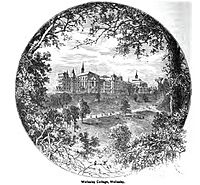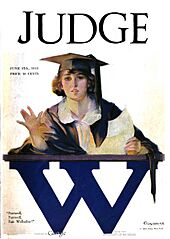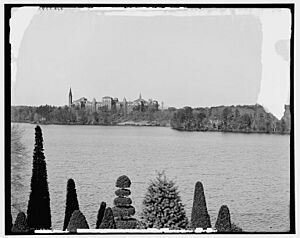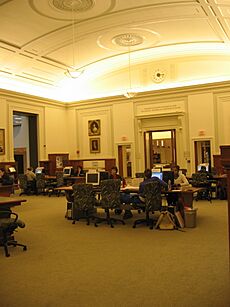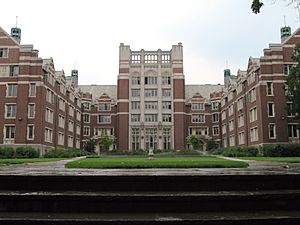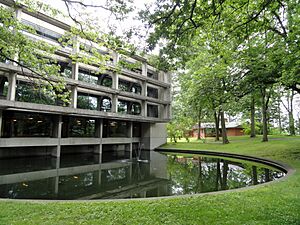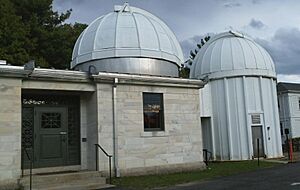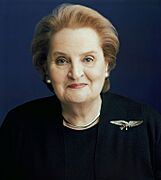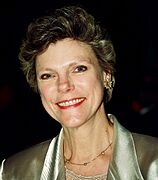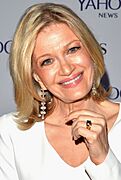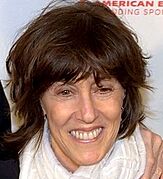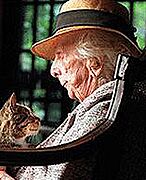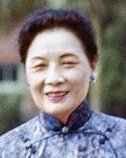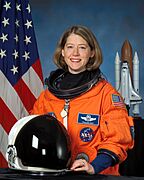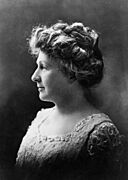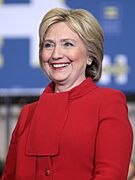Wellesley College facts for kids
 |
|
|
Former names
|
Wellesley Female Seminary (1870–1873) |
|---|---|
| Motto | Non Ministrari sed Ministrare (Latin) |
|
Motto in English
|
Not to be ministered unto, but to minister |
| Type | Private women's liberal arts college |
| Established | 1870 (chartered) 1875 (commenced classes) |
| Accreditation | NECHE |
|
Academic affiliations
|
|
| Endowment | $2.8 billion (2023) |
| President | Paula A. Johnson |
|
Academic staff
|
346 (2019) |
| Undergraduates | 2,417 (2023) |
| Location |
,
United States
42°17′33″N 71°18′27′′W / 42.29250°N 71.30750°W |
| Campus | Suburban (college town), 500 acres (200 ha) |
| Colors | Wellesley Blue |
| Nickname | Blue |
|
Sporting affiliations
|
|
| Mascot | The Blue |
 |
|
Wellesley College is a private college for women in Wellesley, Massachusetts, United States. It is a liberal arts college, which means it offers a wide range of subjects in the arts, humanities, sciences, and social sciences.
The college was started in 1870 by Henry and Pauline Durant. They wanted to create a place where women could get a great education. Wellesley is part of a group called the Seven Sisters Colleges, which were historically women's colleges in the northeastern United States.
About 2,500 students attend Wellesley College. They can choose from 60 different majors. The college also has over 150 student clubs and groups. Wellesley athletes compete in NCAA Division III sports. The campus is large, covering 500 acres (200 ha), and has a museum and a beautiful botanic garden.
Contents
College History
Wellesley College was founded by Pauline and Henry Fowle Durant. They believed strongly that women should have good chances for education. They wanted the college to prepare women for "great conflicts, for vast reforms in social life."
The college officially started on March 17, 1870. It was first called the "Wellesley Female Seminary." On March 7, 1873, its name changed to Wellesley College. The college welcomed its first students on September 8, 1875. At first, the campus was in a town called Needham. But in 1881, that area became a new town called Wellesley.
Wellesley College was a leader in science education for women. From 1875 to 1921, it hired more female scientists than any other college in the U.S. It was also one of the first colleges to offer science classes with labs for students. In 1896, Sarah Frances Whiting, a physics and astronomy professor, was among the first U.S. scientists to experiment with X-rays.
The first president of Wellesley was Ada Howard. Many other leaders have guided the college since then, including the current president, Paula Johnson.
The college's first main building was College Hall. It was very large, about 150 meters (500 ft) long and five stories tall. It opened in 1875 and was used for both classes and student housing. Sadly, on March 17, 1914, College Hall was destroyed by a fire. No one ever found the exact cause of the fire. Today, a group of student dorms called the Tower Court complex stands where College Hall once was.
After the fire, the college made a new plan in 1921 and built several new buildings. During World War II, the college had a program for naval officers. The college president at that time, Mildred McAfee, even took time off to lead the Women's Reserve of the U.S. Navy.
College Campus
The Wellesley campus is 500 acres (200 ha) and overlooks Lake Waban. It has forests, open fields, and beautiful scenery. A famous landscape architect, Frederick Law Olmsted Jr., said Wellesley's campus was unique and very beautiful. The campus is next to the private Hunnewell Estates Historic District, where you can see lovely gardens from the lake.
The first plan for Wellesley's campus was made in 1921. This plan focused on the natural landscape, which was different from other colleges that often built around courtyards. The hills and natural areas of the campus helped shape where buildings were placed. This made the college buildings fit well into the natural surroundings.
Students at Wellesley have many choices for where to live. There are 17 different dorms, including Tower Court, the Quad, and the "New Dorms." Some dorms are even special houses for students who want to speak Spanish or French.
In 2011, Travel+Leisure magazine named Wellesley one of the most beautiful college campuses in the United States.
Green Hall, built in 1931, is a notable building on campus. It has the Galen L. Stone Tower, which holds 32 bells called a carillon. Students often play the carillon between classes.
Houghton Chapel was built in 1899. It is a beautiful gray stone building with stained glass windows. The chapel is used for many events, like lectures, music concerts, and religious services.
The main library, Clapp Library, was built with money donated by Andrew Carnegie in 1905. It has been expanded and updated several times over the years. In 1974, it was renamed for Margaret Clapp, a former college president and author.
The Davis Museum, which opened in 1993, was designed by a famous architect named Rafael Moneo. It holds art collections from all over the world, from ancient times to modern art. Admission to the museum is free for everyone.
College Leadership
The current president of Wellesley College is Paula Johnson. She became the 14th president in July 2016. Before coming to Wellesley, President Johnson was a professor at Harvard Medical School.
Wellesley College often raises money to support its programs and students. In 2005, the college raised over $472 million, which was a record for liberal arts colleges. In late 2015, they started another fundraising effort with a goal of $500 million. Many famous graduates, like Madeleine Albright and Hillary Clinton, helped with this effort.
Wellesley Centers for Women
The Wellesley Centers for Women (WCW) is a large research group in the United States. It focuses on social science research related to women and gender. WCW was formed in 1995 when two smaller centers joined together.
The Wellesley Centers for Women studies five main areas: education, financial security, mental health, youth development, and violence. They also have programs that create learning materials, offer training, and help build new ideas in these fields.
Academics and Learning
Wellesley classes are usually small, with about 17 to 20 students. There is one teacher for every seven students. The college offers 60 different majors. Students can even create their own major if they have a special interest.
Wellesley also has a special program for students over the age of 24. This program, called the Elisabeth Kaiser Davis Degree Program, helps women who could not finish their college degree earlier in life. These students take the same classes as younger students and can live on campus. Their different life experiences add a lot to the college community.
Wellesley has programs with other colleges like the Massachusetts Institute of Technology (MIT) and the Olin College of Engineering. This allows students to earn two degrees, one from Wellesley and one from these other schools. Wellesley also works with Brandeis University for a special five-year program where students can earn a master's degree.
Students can also take classes at other nearby colleges, including MIT, Babson College, Olin College, and Brandeis University.
The most popular majors for students who graduated in 2023 were:
- Economics
- Computer Sciences
- Psychology
- Political Science
- Biological Sciences
- Neuroscience
- Mathematics
- English
College Admissions
| USNWR Liberal Arts College | 7 |
|---|---|
| Washington Monthly Liberal Arts | 20 |
| Forbes | 23 |
Wellesley College is known for being very selective in its admissions. For the class that started in fall 2019, the middle 50% of students had SAT scores between 1370 and 1510 for reading and math. Their ACT scores were between 31 and 34. For the class starting in fall 2024, Wellesley received a record number of applications, over 8,900. About 13% of these students were offered admission.
Wellesley has a special program for students who are older than 24. This program, started in 1971, is called the Elizabeth Kaiser Davis Degree Program. It helps women who started college but could not finish their degree earlier. These students are fully part of the Wellesley community.
Tuition and Financial Help
For the 2024–2025 school year, Wellesley's yearly cost was $92,060. This includes tuition and other fees. In 2020–2021, the average financial aid package was over $56,000. This aid helps many students afford to attend Wellesley.
College Rankings
U.S. News & World Report ranked Wellesley seventh among national liberal arts colleges in the U.S. for 2025. It was also ranked first among women's colleges. The college was also recognized for being a "best value" and for its strong undergraduate teaching.
In 2024, Washington Monthly ranked Wellesley 20th among liberal arts colleges. This ranking looks at how much colleges help the public good, like helping students from all backgrounds and supporting research.
Forbes magazine also ranked Wellesley 23rd among the top 500 U.S. colleges for 2024–25.
Student Life
Almost all Wellesley students, about 98%, live on campus.
For over 50 years, Wellesley has had a program with MIT. This allows students to take classes at MIT and even do research there. Students can also take classes at nearby Babson College, Brandeis University, and Olin College of Engineering. The college also has exchange programs with other small colleges across the country.
Student Groups
Wellesley College has about 180 student groups. WZLY is the college's radio station, run entirely by students. It is one of the oldest women's college radio stations in the country.
Students can also join various clubs and organizations. There are several social groups called "societies" that focus on different interests, like theater, literature, arts, music, and politics.
Sports and Athletics
Wellesley has 13 varsity sports teams. These include basketball, crew, cross country, fencing, field hockey, golf, lacrosse, soccer, softball, swimming & diving, tennis, track & field, and volleyball. Wellesley's sports teams are known as "the Blue," which is also the school's color. Wellesley competes in the NCAA Division III.
The Wellesley College Crew Team, also called "Blue Crew," started in 1970. It was the first women's college rowing team in the country. In 2016, Blue Crew won the NCAA Division III Rowing Championship for the first time. They won again in 2022 and 2023. This was a big achievement for the college.
Wellesley also has club sports teams like archery, skiing, equestrian, ice hockey, rugby, sailing, squash, Ultimate Frisbee, and water polo.
Crew Team Success
Wellesley College's first Varsity 8+ boat won national championships in 2016 and 2023 at the NCAA Rowing Championships. The head coach, Tessa Spillane, has been named NCAA Division III Rowing Coach of the Year multiple times. The coaching staff also received national awards in 2016 and 2022.
College Traditions
Hoop rolling is a fun yearly tradition at Wellesley that started in 1895. Each senior student gets a wooden hoop, often passed down from older students. Before graduation, the seniors, wearing their graduation robes, race while rolling their hoops. The winner is carried by her classmates and thrown into Lake Waban. In the past, people said the winner would be the first to marry. Now, it's said the winner will be the first to achieve success, however she defines it.
The Wellesley campus is located near the halfway point of the Boston Marathon race. Students come out to cheer for the runners in what is called the "Scream Tunnel." This tradition started when students cheered for the first woman to run the marathon in 1966. Since then, it has become a popular day for students to celebrate the runners and enjoy a break from studying.
Famous People from Wellesley
Notable Graduates
Many Wellesley graduates have become successful in different fields, like business, government, and the arts.
Some famous graduates include:
- Madeleine Albright ('59), who was the first female U.S. Secretary of State. She often returned to Wellesley to teach students about global affairs.
- Hillary Rodham Clinton ('69), who was a U.S. Senator, Secretary of State, and a presidential candidate.
- Katharine Lee Bates, who wrote the words to the song "America the Beautiful."
- Annie Jump Cannon, a famous astronomer who classified thousands of stars.
- Pamela Melroy, an astronaut.
- Nora Ephron, a well-known writer and director.
- Journalists like Diane Sawyer and Cokie Roberts.
- Soong Mei-ling, who was the First Lady of the Republic of China.
Notable Teachers
Many important people have taught at Wellesley College, including:
- Emily Greene Balch, an economist and peace activist.
- Katharine Lee Bates, a poet and writer.
- Vladimir Nabokov, a famous novelist.
- Sarah Frances Whiting, a physicist and astronomer.
See also
 In Spanish: Wellesley College para niños
In Spanish: Wellesley College para niños
- Wellesley College Botanic Gardens
- Women's colleges in the United States
- Mona Lisa Smile, a fictional movie about Wellesley in the 1950s


